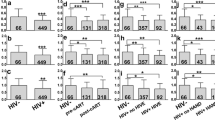Summary
Those large neutral amino acids (LNAA) which compete with each other for the carrier mediated transport from plasma into the brain were determined in plasma in human immunodeficiency virus (HIV-1) seropositive subjects and seronegative controls. Previous findings of a decreased concentration of tryptophan were confirmed whereas no difference between HIV-1 seropositive subjects and controls were found in those LNAAs with which tryptophan competes for the transport into the brain. Thus, the ratio in plasma of tryptophan to the total LNAA concentration was decreased in HIV-1 seropositive subjects. This ratio is considered to, at least partly, regulate the availability of tryptophan in the brain. Since tryptophan is a precursor to the neurotransmitter 5-HT and since the enzymes involved in the 5-HT synthesis normally are not saturated, the decreased plasma ratio of tryptophan might cause a decrease in brain 5-HT synthesis and, thus, to an impaired function in brain 5-HT neurons. This mechanism might, as well as previously demonstrated accumulation within the brain of the neurotoxic tryptophan metabolite quinolinic acid, contribute to the development of dementia and other neuro-psychiatric disorders, often seen in AIDS patients. Treatment with 5-HT receptor agonists might prove effective to prevent neuro-psychiatric disorders.
Similar content being viewed by others
References
Eriksson T, Carlsson A (1988) β-Adrenergic control of brain uptake of large neutral amino acids. Life Sci 42: 1583–1589
Fernstrom JD (1983) Role of precursor availability in control of monoamine biosynthesis in brain. Physiol Rev 63: 484–546
Heyes MP, Brew BJ, Saito K, Quearry BJ, Price RW, Lee K, Bhalla RB, Der M, Markey SP (1992a) Inter-relationships between quinolinic acid, neuroactive kynurenines, neopterin and β2-microglobulin in cerebrospinal fluid and serum of HIV-1-infected patients. J Neuroimmunol 40: 71–80
Heyes MP, Saito K, Crowley JS, Davis LE, Demitrack MA, Der M, Dilling LA, Elia J, Kruesi MJP, Lackner A, Larsen SA, Lee K, Leonard HL, Markey SP, Martin A, Milstein S, Mouradian MM, Pranzatelli MR, Quearry BJ, Salazar A, Smith M, Strauss SE, Sunderland T, Swedo SW, Tourtellotte WW (1992b) Quinolinic acid and kynurenine pathway metabolism in inflammatory and non-inflammatory neurological disease. Brain 115: 1249–1273
Hortin GL, Landt M, Powderly WG (1994) Changes in plasma amino acid concentrations in response to HIV-1 infection. Clin Chem 40: 785–789
Larsson M, Hagberg L, Norkrans G, Forsman A (1989) Indole amine deficiency in blood and cerebrospinal fluid from patients with human immunodeficiency virus infection. J Neurosci Res 23: 441–446
Lidberg L, Belfrage H (1991) Mentally disordered offenders in Sweden. Bull Am Acad Psychiatry Law 19: 389–393
Lindroth P, Mopper K (1979) High performance liquid Chromatographic determination of subpicomole amounts of amino acids by precolumn fluorescence derivatization with o-phthaldialdehyde. Anal Chem 51: 1667–1674
Navia BA, Price RW (1987) The acquired immunodeficiency dementia complex as the presenting or sole manifestation of human immunodeficiency virus infection. Arch Neurol 44: 65–69
Oldendorf WH (1975) Permeability of the blood-brain barrier. In: Tower DB (ed) The nervous system: the basic neurosciences. Raven Press, New York, pp 279–289
Pardridge WM (1977) Regulation of amino acid availability to the brain. In: Wurtman RJ, Wurtman JJ (eds) Nutrition and brain, vol 1. Raven Press, New York, pp 141–204
Rothman SM, Olney JW (1987) Excitoxicidy and the NMDA receptor. Trends Neurosci 10: 299–302
Schwarcz R, Foster AC, French ED, Whetsell WO, Köhler C (1984) Excitoxic models for neurodegenerative disorders. Life Sci 35: 19–32
Taylor MW, Feng G (1991) Relationship between interferon-γ, indoleamine 2,3- dioxygenase, and tryptophan catabolism. FASEB J 5: 2516–2522
Werner ER, Fuchs D, Hausen A, Jaeger, H, Reibnegger, Werner-Felmayer G, Dierich MP, Wachter H (1988) Tryptophan degradation in patients infected by human immunodeficiency virus. Biol Chem Hoppe Seyler 369: 337–340
Wiegand M, Möller AA, Schreiber W, Krieg JC, Fuchs D, Wachter H, Holsboer F (1991) Nocturnal sleep EEG in patients with HIV infection. Eur Arch Psychiatry Clin Neurosci 240: 153–158
Wurtman RJ, Fernstrom JD (1976) Control of brain neurotransmitter synthesis by precursor availability and nutritional state. Biochem Pharmacol 25: 1691–1696
Author information
Authors and Affiliations
Rights and permissions
About this article
Cite this article
Eriksson, T., Lidberg, L. Decreased plasma ratio of tryptophan to competing large neutral amino acids in human immunodeficiency virus type 1 infected subjects: Possible implications for development of neuro-psychiatric disorders. J. Neural Transmission 103, 157–164 (1996). https://doi.org/10.1007/BF01292624
Received:
Accepted:
Issue Date:
DOI: https://doi.org/10.1007/BF01292624



